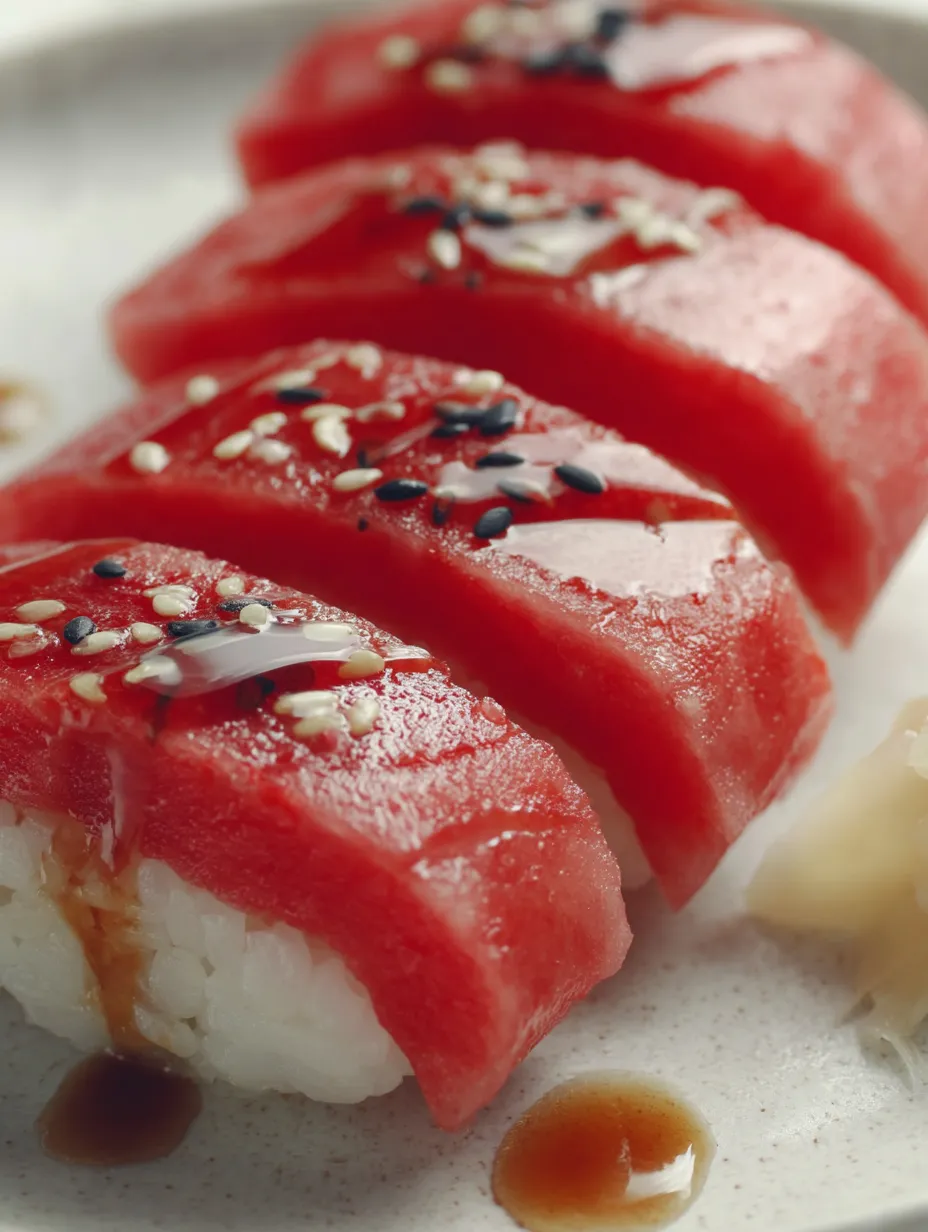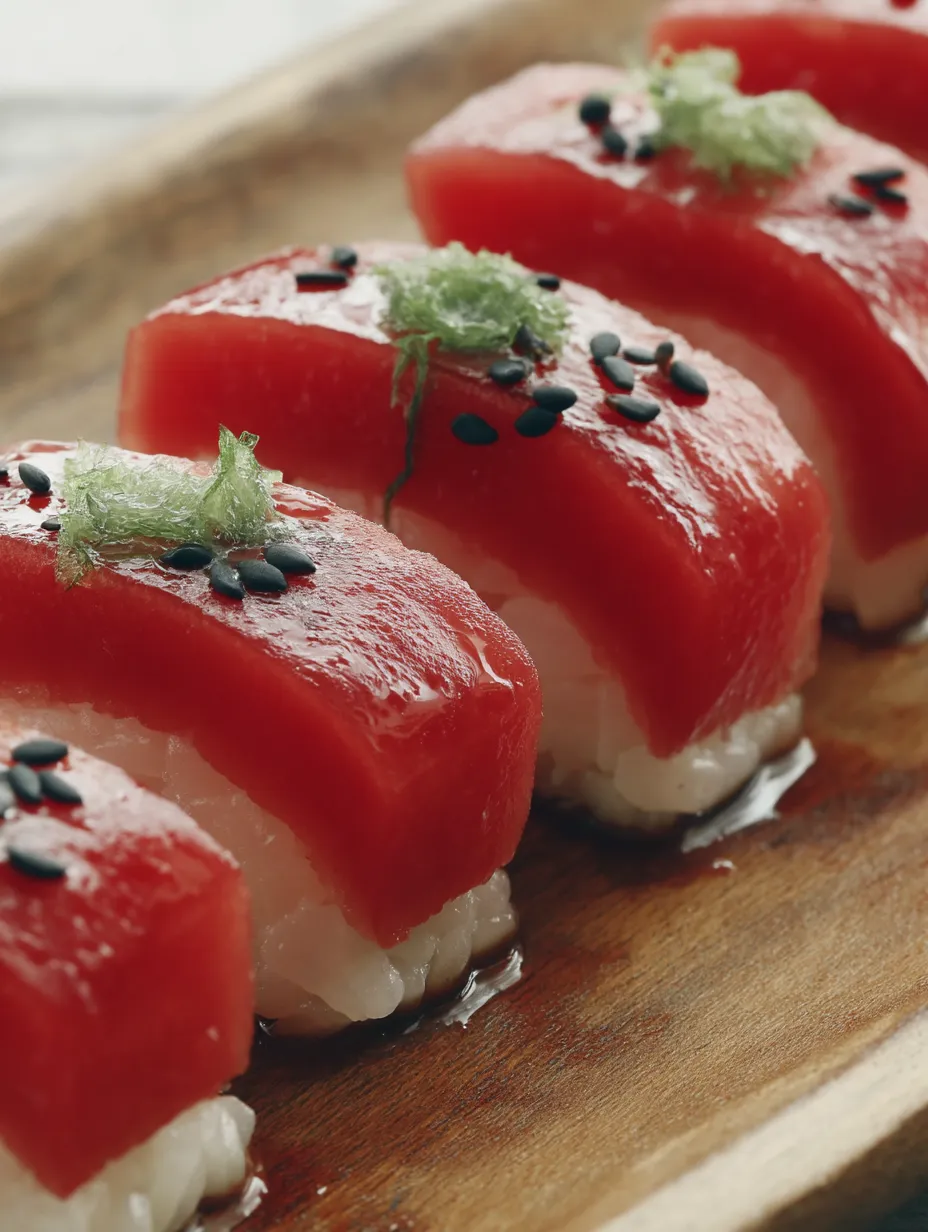 Pin it
Pin it
This plant-based watermelon sushi transforms an ordinary fruit into an extraordinary culinary experience that mimics the look and texture of tuna. The slow roasting process concentrates the watermelon's sweetness while the umami-rich marinade creates a savory profile that will surprise and delight both vegans and sushi lovers alike.
I first served this at a summer gathering where several guests were pescatarians. The looks on their faces when I revealed the "tuna" was actually watermelon was priceless. Now it's become my signature dish that friends specifically request when they visit.
Ingredients
- Seedless watermelon: forms the foundation of our vegan "tuna" and transforms remarkably through cooking
- Sunflower oil: helps the watermelon develop a beautiful exterior during roasting
- Tamari: delivers the essential umami flavor that makes this dish convincingly savory
- Mirin: provides subtle sweetness that balances the savory elements
- Sesame oil: adds authentic Japanese flavor notes and nutty depth to the marinade
- Rice vinegar: brings brightness to both the marinade and sushi rice
- Sushi rice: provides the authentic sticky base needed for proper sushi structure
- Raw caster sugar: balances the acidity in the rice seasoning
- Salt: enhances all flavors and is critical for properly seasoned sushi rice
- Pickled ginger: offers the traditional palate cleanser and beautiful color contrast
Step-by-Step Instructions
- Prepare the Watermelon:
- Cut two rectangular blocks from your watermelon measuring approximately 10cm by 2.5cm each. Look for the most dense, uniformly colored portion of your watermelon. Place these blocks in an ovenproof dish that has been lightly coated with sunflower oil. Drizzle the remaining oil over the watermelon pieces to encourage proper caramelization.
- Roast the Watermelon:
- Preheat your oven to 180°C or 350°F. Place the oiled watermelon in the oven and roast for a full 20 minutes. The watermelon will begin to condense and shrink slightly as water evaporates. After the initial roasting period, carefully flip each piece over and continue roasting for another 10 minutes. This creates even caramelization and concentration of flavors.
- Create the Marinade:
- While the watermelon roasts, combine the tamari, mirin, sesame oil, and rice vinegar in a bowl large enough to hold your watermelon pieces. Whisk thoroughly to emulsify the oils with the other liquids. This marinade will transform the watermelon from sweet to savory, so ensure ingredients are well balanced.
- Marinate the Watermelon:
- Once the watermelon has finished roasting, transfer the still warm pieces directly into your prepared marinade. The warm watermelon will absorb the flavors more effectively. Cover the container and allow to rest at room temperature for 20 minutes, then transfer to the refrigerator for at least 1 hour or ideally overnight for maximum flavor infusion.
- Prepare the Sushi Rice:
- Thoroughly rinse your sushi rice in cold water, swishing with your fingers until the water runs clear. This removes excess starch and ensures proper texture. Combine the rinsed rice with cold water in a medium saucepan. Bring to a boil, then reduce heat and simmer covered for approximately 15 minutes until water is absorbed.
- Season the Rice:
- Combine rice vinegar, sugar, and salt in a small bowl, stirring until completely dissolved. Once the rice has finished cooking, let it stand covered for 10 minutes. Transfer the rice to a wide, nonmetallic bowl and drizzle the seasoning mixture over it. Use a cutting motion with a rice paddle or wooden spoon to incorporate the seasoning while allowing excess moisture to evaporate.
- Shape the Sushi Base:
- Once the rice has cooled to room temperature, wet your hands to prevent sticking and shape portions of rice into rectangular logs approximately 5cm long. The rice should be firm enough to hold its shape but not compressed so tightly that it becomes dense and chewy.
- Assemble the Sushi:
- Remove the marinated watermelon from the refrigerator and slice it at a slight angle into pieces approximately 3mm thick. The angle creates larger slices that drape elegantly over the rice. Place each slice atop a rice log, allowing it to slightly overlap the edges for the authentic nigiri appearance.
- Garnish and Serve:
- Place a small amount of pickled ginger atop each piece or on the side of your serving platter. For an authentic presentation, serve with additional tamari for dipping and a small dab of wasabi if desired.
 Pin it
Pin it
I discovered this technique when searching for creative sushi options for my sister who recently became vegan. The first time I made it, I was genuinely shocked at how the texture transforms from crisp and watery to something with a genuine meaty bite. My favorite part is watching guests' faces when they take their first bite and realize they've been completely fooled by watermelon.
Storage Tips
Properly stored, assembled watermelon sushi will keep in the refrigerator for up to 24 hours, though the texture is best when consumed within a few hours of assembly. If you need to prepare components in advance, the marinated watermelon can be kept refrigerated for up to 3 days, improving in flavor each day. The sushi rice is best used the same day it's prepared, but can be stored covered in the refrigerator for up to 2 days. Bring rice back to room temperature before assembling.
Creative Variations
This versatile technique opens doors to countless flavor variations. Try adding thin slices of avocado between the rice and watermelon for added creaminess. For a spicy version, incorporate a small amount of sriracha or chili oil into the marinade. You can also experiment with smoking the watermelon before marinating for even more depth. During summer months, grilling the watermelon instead of roasting adds wonderful charred notes that complement the savory marinade beautifully.
 Pin it
Pin it
Serving Suggestions
Present this watermelon sushi on a minimalist slate or wooden board for maximum visual impact. Accompany with traditional sushi companions like wasabi, pickled ginger, and high quality tamari or soy sauce. For a complete meal, serve alongside miso soup, a simple cucumber salad dressed with rice vinegar, and edamame with flaky sea salt. This makes an impressive first course for a larger Asian inspired meal or can stand alone as a light dinner with a few complementary sides.
Frequently Asked Questions
- → How does watermelon mimic tuna?
Slow roasting the watermelon concentrates its natural sweetness and softens it, while the marinade of tamari, mirin, sesame oil, and rice vinegar adds complex umami flavors that resemble tuna.
- → Can I prepare this in advance?
Yes! The roasted and marinated watermelon can be refrigerated overnight, and the sushi rice can be cooled and covered with a damp cloth ahead of time for easy assembly later.
- → What gives the dish its distinct flavor?
The marinade's components, such as tamari, sesame oil, mirin, and rice vinegar, combine to create a savory, tangy, and slightly sweet profile that elevates the entire dish.
- → Can I use different ingredients for the marinade?
While the described marinade delivers the best flavor, you can experiment with soy sauce as a tamari alternative or adjust sweetness and tang to taste with additional mirin or vinegar.
- → What’s the best way to serve watermelon sushi?
Serve it chilled over perfectly shaped sushi rice logs and garnish with pickled ginger. Pair it with soy sauce or wasabi for added flavor.
